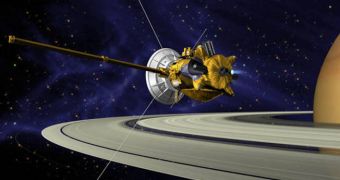The Cassini-Huygens mission is, at this point, one of the most abundant sources of information about celestial bodies in the solar system, alongside the Mars Reconnaissance Orbiter (MRO), and the rovers Spirit and Opportunity. A decade ago, the space probe was last seen orbiting the Earth, as it made a fly-by to boost its speed enough to get to Saturn as fast as possible. Mission planners and controllers at NASA, ESA and the Italian Space Agency are currently celebrating the achievement, and they have reason to be joyful – the mission has been already extended over its planned duration.
Although it was launched in October 1997, the space probe did not leave the inner solar system until August 1999. The reason for that was that it did not have sufficient speed to make the trip to the second largest inhabitant in the system in a period of time smaller than a decade. So, it turned to the slingshot effect, and carried out a total of four fly-by maneuvers, two around Venus, one around the Earth and another one later on, around Jupiter.
The Earth phase was sufficient to boost its speed by about 5.5 kilometers per second (or about 12,000 miles per hour). Overall, the four in-flight moves boosted the probe's speed by more than 21.44 kilometers (13.64 miles) per second, enough to get it to Saturn within five years. It reached its destination on June 30th, 2004, when it was successfully captured by the gas giant's gravitational pull. Since then, it has been constantly beaming back a wealth of information about the planet, its moons and moonlets, as well as its rings.
It is responsible for everything we know now about Titan and Enceladus, and it led astronomers to find that methane existed on the former, and ice on the latter. It has also discovered a large number of other bodies orbiting the planet, which are so small that they were detected only by their shades. The craft also used its spectrometers to analyze the gas giant's rings for traces of ice and dust, and determined that Enceladus spewed ice through its volcanoes outside its atmosphere, and into the rings.
The main instruments on Cassini include:
Optical Remote Sensing
Mounted on the remote-sensing pallet, these instruments study Saturn and its rings and moons in the electromagnetic spectrum. Composite Infrared Spectrometer (CIRS). Imaging Science Subsystem (ISS). Ultraviolet Imaging Spectrograph (UVIS). Visible and Infrared Mapping Spectrometer (VIMS).
Fields, Particles and Waves
These instruments study the dust, plasma and magnetic fields around Saturn. While most don't produce actual "pictures," the information they collect is critical to scientists' understanding of this rich environment. Cassini Plasma Spectrometer (CAPS). Cosmic Dust Analyzer (CDA). Ion and Neutral Mass Spectrometer (INMS). Magnetometer (MAG). Magnetospheric Imaging Instrument (MIMI). Radio and Plasma Wave Science (RPWS).
Microwave Remote Sensing
Using radio waves, these instruments map atmospheres, determine the mass of moons, collect data on ring-particle size, and unveil the surface of Titan. Radar. Radio Science (RSS).
The Cassini-Huygens mission is a cooperative project of NASA, the European Space Agency and the Italian Space Agency. The Cassini orbiter was designed, developed and assembled at the Jet Propulsion Laboratory, in Pasadena, California. The JPL manages the mission for the Science Mission Directorate at the NASA Headquarters in Washington. More information about the Cassini mission is available here and here.

 14 DAY TRIAL //
14 DAY TRIAL //